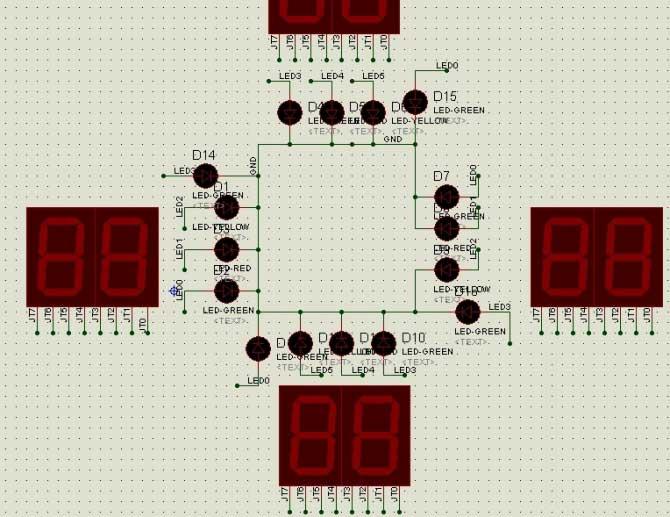1. 声明GPIO_Port_J_ISR函数代码:该函数是在main中定义的,在startup_ewarm.c文件中使用前,要先声明一下
//*****************************************************************************
//
// External declarations for the interrupt handlers used by the application.
//
//*****************************************************************************
extern void GPIO_Port_J_ISR(void);
2. 中断映射表
//*****************************************************************************
//
// The vector table. Note that the proper constructs must be placed on this to
// ensure that it ends up at physical address 0x0000.0000.
//
//*****************************************************************************
__root const uVectorEntry __vector_table[] @ ".intvec" =
{
{ .ulPtr = (unsigned long)pulStack + sizeof(pulStack) },
// The initial stack pointer
__iar_program_start, // The reset handler
NmiSR, // The NMI handler
FaultISR, // The hard fault handler
IntDefaultHandler, // The MPU fault handler
IntDefaultHandler, // The bus fault handler
IntDefaultHandler, // The usage fault handler
0, // Reserved
0, // Reserved
0, // Reserved
0, // Reserved
IntDefaultHandler, // SVCall handler
IntDefaultHandler, // Debug monitor handler
0, // Reserved
IntDefaultHandler, // The PendSV handler
IntDefaultHandler, // The SysTick handler
IntDefaultHandler, // GPIO Port A
IntDefaultHandler, // GPIO Port B
IntDefaultHandler, // GPIO Port C
IntDefaultHandler, // GPIO Port D
IntDefaultHandler, // GPIO Port E
IntDefaultHandler, // UART0 Rx and Tx
IntDefaultHandler, // UART1 Rx and Tx
IntDefaultHandler, // SSI0 Rx and Tx
IntDefaultHandler, // I2C0 Master and Slave
IntDefaultHandler, // PWM Fault
IntDefaultHandler, // PWM Generator 0
IntDefaultHandler, // PWM Generator 1
IntDefaultHandler, // PWM Generator 2
IntDefaultHandler, // Quadrature Encoder 0
IntDefaultHandler, // ADC Sequence 0
IntDefaultHandler, // ADC Sequence 1
IntDefaultHandler, // ADC Sequence 2
IntDefaultHandler, // ADC Sequence 3
IntDefaultHandler, // Watchdog timer
IntDefaultHandler, // Timer 0 subtimer A
IntDefaultHandler, // Timer 0 subtimer B
IntDefaultHandler, // Timer 1 subtimer A
IntDefaultHandler, // Timer 1 subtimer B
IntDefaultHandler, // Timer 2 subtimer A
IntDefaultHandler, // Timer 2 subtimer B
IntDefaultHandler, // Analog Comparator 0
IntDefaultHandler, // Analog Comparator 1
IntDefaultHandler, // Analog Comparator 2
IntDefaultHandler, // System Control (PLL, OSC, BO)
IntDefaultHandler, // FLASH Control
IntDefaultHandler, // GPIO Port F
IntDefaultHandler, // GPIO Port G
IntDefaultHandler, // GPIO Port H
IntDefaultHandler, // UART2 Rx and Tx
IntDefaultHandler, // SSI1 Rx and Tx
IntDefaultHandler, // Timer 3 subtimer A
IntDefaultHandler, // Timer 3 subtimer B
IntDefaultHandler, // I2C1 Master and Slave
IntDefaultHandler, // Quadrature Encoder 1
IntDefaultHandler, // CAN0
IntDefaultHandler, // CAN1
IntDefaultHandler, // CAN2
IntDefaultHandler, // Ethernet
IntDefaultHandler, // Hibernate
IntDefaultHandler, // USB0
IntDefaultHandler, // PWM Generator 3
IntDefaultHandler, // uDMA Software Transfer
IntDefaultHandler, // uDMA Error
IntDefaultHandler, // ADC1 Sequence 0
IntDefaultHandler, // ADC1 Sequence 1
IntDefaultHandler, // ADC1 Sequence 2
IntDefaultHandler, // ADC1 Sequence 3
IntDefaultHandler, // I2S0
IntDefaultHandler, // External Bus Interface 0
GPIO_Port_J_ISR // GPIO Port J
};
#include "inc/hw_memmap.h"
#include "inc/hw_types.h"
#include "driverlib/gpio.h"
#include "driverlib/uart.h"
#include "utils/uartstdio.h"
#include "driverlib/sysctl.h"
#include "driverlib/interrupt.h"
#include "inc/hw_ints.h"
//*****************************************************************************
// 数据类型定义区
//*****************************************************************************
typedef unsigned char BYTE; // 8 bit
typedef unsigned short WORD; // 16 bit
typedef unsigned long DWORD; // 32 bit
typedef enum {FALSE = 0, TRUE = !FALSE} bool;
/* 寄存器地址 ---------------------------------------------------------------*/
#define GPIO_PORTF_APB_DIR_R 0x40025400
#define GPIO_PORTF_APB_DEN_R 0x4002551C
/* 用于调试 PF1 LED -----------------------------------------------------*/
#define LED_PERIPH SYSCTL_PERIPH_GPIOF
#define LED_PORT GPIO_PORTF_BASE
#define LED_PIN GPIO_PIN_1
#define LED_OFF 1 << 1
#define LED_ON ~(1 << 1) // 低电平点亮LED
//*****************************************************************************
//
// 延时函数
//
//*****************************************************************************
void Delay(volatile signed long nCount)
{
for(; nCount != 0; nCount--);
}
//*****************************************************************************
//
// LED初始化函数,用于调试timer, watchdog等
//
//*****************************************************************************
void LED_Init(void)
{
// 使能LED所在的GPIO端口
SysCtlPeripheralEnable(LED_PERIPH);
// 设置LED所在管脚为输出
GPIOPinTypeGPIOOutput(LED_PORT, LED_PIN);
// 熄灭LED(默认LED是点亮的,低电平点亮LED)
GPIOPinWrite(LED_PORT, LED_PIN, LED_ON);
}
//*****************************************************************************
//
// PJ7管脚设置为,双沿触发中断方式
//
//*****************************************************************************
void GPIO_PJ7_Init(void)
{
// 使能GPIOJ端口
SysCtlPeripheralEnable(SYSCTL_PERIPH_GPIOJ);
// 设置PJ7管脚为输入
GPIOPinTypeGPIOInput(GPIO_PORTJ_BASE, GPIO_PIN_7);
// 配置PJ7管脚带弱上拉电阻
GPIOPadConfigSet(GPIO_PORTJ_BASE, GPIO_PIN_7, GPIO_STRENGTH_2MA, GPIO_PIN_TYPE_STD_WPU);
// 设置PJ7管脚的中断类型,双沿触发
GPIOIntTypeSet(GPIO_PORTJ_BASE, GPIO_PIN_7, GPIO_BOTH_EDGES);
UARTprintf("PJ7 is high at begin ->\n");
// 使能GPIOJ端口中断
IntEnable(INT_GPIOJ);
// 使能PJ7管脚的中断
GPIOPinIntEnable(GPIO_PORTJ_BASE, GPIO_PIN_7);
}
//*****************************************************************************
//
// This function sets up UART2 to be used for a console to display information
// as the example is running.
//
//*****************************************************************************
void InitConsole(void)
{
// Enable GPIO port D which is used for UART2 pins.
SysCtlPeripheralEnable(SYSCTL_PERIPH_GPIOD);
// Select the alternate (UART) function for these pins.
GPIOPinTypeUART(GPIO_PORTD_BASE, GPIO_PIN_0 | GPIO_PIN_1);
// Configure the pin muxing for UART0 functions on port A0 and A1.
// This step is not necessary if your part does not support pin muxing.
GPIOPinConfigure(GPIO_PD0_U2RX);
GPIOPinConfigure(GPIO_PD1_U2TX);
// Initialize the UART for console I/O.
UARTStdioInit(2);
UARTprintf("Uart2 is ready ->\n");
}
//*****************************************************************************
//
// 主函数
//
//*****************************************************************************
int main(void)
{
// Set the clocking to run directly from the crystal.
SysCtlClockSet(SYSCTL_SYSDIV_1 | SYSCTL_USE_OSC | SYSCTL_OSC_MAIN | SYSCTL_XTAL_16MHZ);
LED_Init(); // 初始化LED,输出
InitConsole(); // UART2初始化
GPIO_PJ7_Init(); // 初始化PJ7管脚,输入
IntMasterEnable(); // 开总中断
GPIOPinWrite(LED_PORT, LED_PIN, LED_OFF);
Delay(0xFFFFF);
GPIOPinWrite(LED_PORT, LED_PIN, LED_ON);
Delay(0xFFFFF);
GPIOPinWrite(LED_PORT, LED_PIN, LED_OFF);
Delay(0xFFFFF);
GPIOPinWrite(LED_PORT, LED_PIN, LED_ON);
Delay(0xFFFFF);
GPIOPinWrite(LED_PORT, LED_PIN, LED_OFF);
Delay(0xFFFFF);
GPIOPinWrite(LED_PORT, LED_PIN, LED_ON);
Delay(0xFFFFF);
while (1)
{
Delay(0xFFFFF); // 646ms
}
}
//*****************************************************************************
//
// PJ7管脚的中断服务函数,双沿触发
//
//*****************************************************************************
void GPIO_Port_J_ISR(void)
{
// 读取中断状态,GPIOJ端口的8个管脚都可能触发中断
DWORD Status = GPIOPinIntStatus(GPIO_PORTJ_BASE, true);
// 清除中断状态,重要
GPIOPinIntClear(GPIO_PORTJ_BASE, Status);
if ((Status & GPIO_PIN_7) != 0)
{
// 上升沿中断处理函数
if (0x00000080 == GPIOPinRead(GPIO_PORTJ_BASE, GPIO_PIN_7))
{
UARTprintf("PJ7 is low to high ->\n");
Delay(0xFFFFF);
}
else if (0 == GPIOPinRead(GPIO_PORTJ_BASE, GPIO_PIN_7)) // 下降沿中断处理函数
{
UARTprintf("PJ7 is high to low ->\n");
Delay(0xFFFFF);
}
}
}
『本文转载自网络,版权归原作者所有,如有侵权请联系删除』
 热门文章
更多
热门文章
更多









